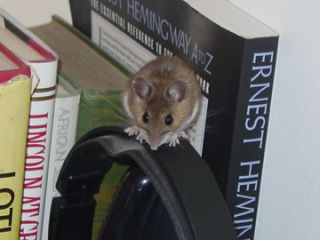
Animal Behavior
My Cat Is a Serial Killer
Does it matter if pets roam free?
Posted February 15, 2013

Zelda waits for a rustling noise from her prey.
I have to admit it; one of my two cats, my beloved Zelda, is a serial killer. She brings a steady stream of field mice, wood rats, voles, moles, birds, lizards, skinks and occasional rabbits or squirrels to the door, calling for me to come see them. Sometimes she eats her prey, leaving me only the least tasty tidbits to admire. Sometimes she asks to trade them for catfood. And what am I to do?
She brings me her dead, expecting and — I confess it — receiving praise. I don't know how to stop her and she is simply fulfilling her nature. How can I withhold my praise?
A collar with a bell is a "fix" I have tried on other cats, to no avail. When they know I am watching, a belled cat will go jingle-jingle-jingle. When they think they are out of sight, a belled cat makes no noise at all. Cats are very clever.
Two recent studies suggest that the killing does matter. Kitty Cam studies, in which lightweight camera were attached to cats, were carried out by the University of Georgia and showed that 30% of house cats kill an average of two animals per week. With about 80 million pet cats in the US, this is a heavy toll: about 520,000,000 kills a year. I know in warm months Zelda kills many more than two a week because some days she brings me three or four dead animals. There are an estimated 80 million feral cats in the US — this is more a wild-ass guess than a true estimate — so the real number of birds and mammals killed may be higher.
A recent study in "Nature Communications" by a trio of scientists tried to estimate the total numbers of animals killed by cats per year. They arrived at an estimate of at 1.4 billion to 3.7 billion bird victims and 6.9 billion to 20.7 billion mammals per year. The problem is that nobody knows how many feral cats there are in the country, so the estimates in this study have a huge potential error. Cat rescuers like NPR blogger Barbara J. King points out that such wild estimates must do more harm than good, possibly causing a backlash against all cats. For her view, go read http://www.npr.org/blogs/13.7/2013/02/03/170851048/do-we-really-know-th…
Before we outlaw the keeping or cats or the allowing of cats outside, I'd like to raise another point. As humans have come to inhabit North America, we have systematically decimated the numbers of predatory animals living here, from large ones like wolves and mountain lions to small ones like coyotes, racoons or even birds of prey. We have unbalanced the ecosystems that make up our country. Most animals can and do reproduce in prodigious numbers, too many to survive. Some of those offspring carry deleterious genes that weaken the species' ability to adapt and survive. In the normal course of things, predators help keep the numbers of prey in check and eliminate the feeble, the ill, or the unfit. This is one of the fundamental premises, proven many times over, behind "Survival of the fittest" and evolution.

Would you rather mice or cats?
But the predators that would once have preyed upon rats or other less welcome species have been hard hit by human activities. We have killed them, trapped them, poisoned them, bulldozed their habitats, knocked down the trees they need to roost or nest in and poisoned the ponds and rivers they drink from. Those species we deem "vermin" still thrive and survive, doing better than before we humans arrived on the scene.
If you think of house cats as the predators we have introduced to North America to carry out the job of suppressing unwanted small species in the ecosystem, you may view the (questionable) numbers of animals they kill differently. Maybe those cats are actually restoring the ecosystem to its original state. Let's not forget to mention dogs, another human "gift" to the ecosystem. Terriers, to cite a single example, were bred specifically to catch rats and other vermin — and even well-fed dogs still do catch and kill many animals.
Before the letters of protest arrive, let me say I am strongly in favor of the survival of as many wild species as possible, even the ones that are not so photogenic or appealing as, say, a hummingbird. I don't want them to be wiped out by cats. And I don't put out bird feeders or waterers because it simply gives my cat the opportunity to kill more unsuspecting birds.
I see little evidence that cats are driving mice or birds or other prey into extinction (the exception being on islands, where they can and do drive native species into extinction). We cannot predict what our world would be like if all domestic predators were eliminated, but I can guarantee it would be different. If you are among those who recoil in horror at the thought of a mouse or rat in your home, think what the world might be like without cats or dogs around.
If you really want to know why the populations of various birds and small mammal species have dropped, don't look at Zelda, look in the mirror. Is your nice suburban yard providing any nesting space or food for wild species? Do you plant trees that fruit (sometimes messily), bushes that provide shelter for nests and dens, or leave dead wood in your yard for the woodpeckers? Do you spray any plant or weed that doesn't fit your gardening scheme with Round-Up or some other poison? Does the restrictive covenant of your neighborhood insist you eliminate messy brambles and weed patches? And yet, are you outraged at the thought of a pack of coyotes in your neighborhood — coyotes which kill pets and sometimes attack small children?
Do you want predators as well as prey, or not? It's all part of the same story, our story, mine and Zelda's and yours. The decision to permit cats or dogs to roam free is not a simple one and we need to think it over carefully with the help of good evidence.



